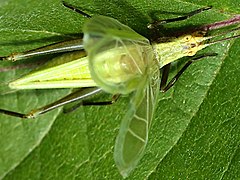
Insects in the family Tettigoniidae are commonly called katydids, or bush crickets. They have previously been known as "long-horned grasshoppers". More than 8,000 species are known. Part of the suborder Ensifera, the Tettigoniidae are the only extant (living) family in the superfamily Tettigonioidea.

Roesel's bush-cricket, Roeseliana roeselii is a European bush-cricket, named after August Johann Rösel von Rosenhof, a German entomologist.

Dolbear's law states the relationship between the air temperature and the rate at which crickets chirp. It was formulated by Amos Dolbear and published in 1897 in an article called "The Cricket as a Thermometer". Dolbear's observations on the relation between chirp rate and temperature were preceded by an 1881 report by Margarette W. Brooks, although this paper went unnoticed until after Dolbear's publication.

Tree crickets are insects of the order Orthoptera. These crickets are in the subfamily Oecanthinae of the family Gryllidae.

Oecanthus is a genus of cricket in subfamily Oecanthinae, the tree crickets.

Tettigonia viridissima, the great green bush-cricket, is a large species of bush-cricket belonging to the subfamily Tettigoniinae.

Crickets are orthopteran insects which are related to bush crickets, and, more distantly, to grasshoppers. In older literature, such as Imms, "crickets" were placed at the family level, but contemporary authorities including Otte now place them in the superfamily Grylloidea. The word has been used in combination to describe more distantly related taxa in the suborder Ensifera, such as king crickets and mole crickets.

Omocestus viridulus, known in the British Isles as the common green grasshopper, is a Palearctic species of grasshopper in the subfamily Gomphocerinae.

Oecanthus pellucens, common name Italian tree cricket, is a species of tree crickets belonging to the family Gryllidae, subfamily Oecanthinae.

Oecanthus fultoni, also known as the snowy tree cricket, or thermometer cricket, is a species of tree cricket from North America. It feeds on leaves but also damages fruit. The chirp of this species is often dubbed onto sound tracks of films and television shows to depict a quiet summer's night. The rate of chirp varies depending on the heat of the environment, allowing a listener to estimate the temperature.

Cyphoderris strepitans, the sagebrush cricket or sagebrush grig, is a one of only a few surviving species in the family Prophalangopsidae. Three of these species are in the genus Cyphoderris and all three are endemic to North America. C. strepitans name is from the Latin word 'strepitans' which means 'making a great noise', refers to their calling song during the mating season.

Oecanthus nigricornis is a "common tree cricket" in the subfamily Oecanthinae. A common name for O. nigricornis is black-horned tree cricket. It is found in North America.

Oecanthus quadripunctatus is a "common tree cricket" in the subfamily Oecanthinae. A common name for O. quadripunctatus is four-spotted tree cricket. It is found in North America.

Oecanthus exclamationis is a "common tree cricket" in the subfamily Oecanthinae. A common name for O. exclamationis is Davis' tree cricket. It is found in North America.

Oecanthus latipennis is a "common tree cricket" in the subfamily Oecanthinae. A common name for O. latipennis is broad-winged tree cricket. It is found in North America.
Oecanthus argentinus, the prairie tree cricket, is a species of tree cricket in the family Gryllidae. It is found in North America and South America.

Oecanthus californicus, the western tree cricket, is a species of tree cricket in the family Gryllidae. It is found in North America.

Oecanthus niveus, known generally as the narrow-winged tree cricket or snowy tree cricket, is a species of tree cricket in the family Gryllidae, which includes all crickets. First noted by Swedish Entomologist Charles de Geer in 1773 by a Pennsylvanian Specimen, it is found primarily in Eastern North America south of Canada, and also in the Caribbean.

Oecanthus dulcisonans is a species of cricket sparsely but widely distributed in the Mediterranean Basin and in the Middle East.

Oecanthus capensis, the Cape thermometer cricket, is a species of tree cricket. It has been found that the rate at which these crickets chirp follows Dolbear's law.




















